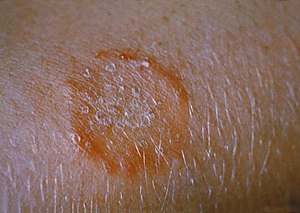Skin fungus infections are hard to recognize. The itching, flaking, redness, and thickened skin of fungal infections can look just like other types of dermatitis or skin allergies. In fact, eczematous skin often becomes infected with fungi, so both are present simultaneously. Doctors use microscopes to help them diagnose skin fungus infections, so there’s no way you can really be sure at home. The Advisory will focus on the five most easily recognized skin fungus infections, but even after looking at the pictures don’t be too confident.
Every year, over 10% of the U.S. population develops this problem. Probably 75% of us will have athlete’s foot at some time during our lives. The most common form occurs between your third, fourth, and fifth toes, sometimes spreading to the sole. Between the toes, your skin becomes white, moist, and easily rubbed off; the tops of the toes may be red, dry, and flaky. Intense itching and burning are the rule. Athlete’s foot usually occurs with hot, moist conditions, or if you wear shoes constantly.
Jock Itch (tinea cruris). The same conditions of heat, moisture (sweat) and poor air circulation leading to athlete’s foot also cause fungus infections of the groin, or jock itch. As its name implies, intense itching and burning are the usual symptoms. You will also find redness, flaking and peeling on the inner thighs, pubic area, and scrotum.
It is caused by a microscopic fungus, not a worm. The infected area spreads out slowly from its central starting point and creates a slightly raised, intensely red ring surrounding a less red, flaky, itchy area. Over weeks, the ring slowly enlarges. It can occur anywhere on the body and in multiple sites at once, so it’s often confused with other kinds of dermatitis.
Theis brownish-red, itchy discoloration affects the underarms, corners of the mouth, rectal area, and beneath the breasts. The same type of fungus causes vaginal yeast infections (candida albicans).
Tinea Versicolor. This fungus actually changes the color of the skin it infects; the patches may be lighter or darker than your normal surrounding skin. This spotted pattern and the fine scaly flakes at the
 margins make this fungal infection the easiest to identify. Since itching and irritation are mild, it’s also the least bothersome.
margins make this fungal infection the easiest to identify. Since itching and irritation are mild, it’s also the least bothersome.
Warmth, humidity, sweating, and poor air circulation all help bring about these fungal infections. But they are contagious, too. Athlete’s foot is believe to be passed on locker room and shower floors, and by sharing footwear and socks; you can acquire tinea versicolor from vinyl surfaces of weight lifting benches; and of course ringworm is contagious through direct contact (usually kids).
Because of all these factors, prevention is a matter of both personal hygiene and minimizing contact with potential carriers or contaminated objects.
There are several effective OTC anti-fungal medications. Because different fungi affect different locations, medications are sometimes specific for those locations. The recommendations below should help you sort it out.
Athlete’s Foot - Tolnaftate is the only OTC medicine approved for both prevention and treatment of athlete’s foot. Be patient, though. It could take a month or more of daily treatment for it to completely clear. Consider preventive use if the condition recurs.
Tinea Versicolor - Although not a Category I agent, selenium sulfide shampoo is universally recognized by dermatologists as an effective OTC remedy for tinea versicolor. Since it often affects large areas of the trunk, applying this shampoo once a day for five minutes, then washing off, is a lot easier and cheaper than using a whole tube of anti-fungal cream twice daily. Tinea versicolor also tends to recur easily, but this shampoo can prevent it if used once a week after the initial 2-4 week treatment cycle.
Candidiasis, Ringworm, and Jock Itch - Miconazole or clotrimazole are quickly effective (1-2 weeks) for each one of these conditions, and come in cream, lotion, or spray. Avoid alcohol-based products since they can sting chafed and delicate skin.
Courtesy--http://quickcare.org/skin/fungus.html
Images-- Wikipedia,Flickr


 sk...">
sk...">